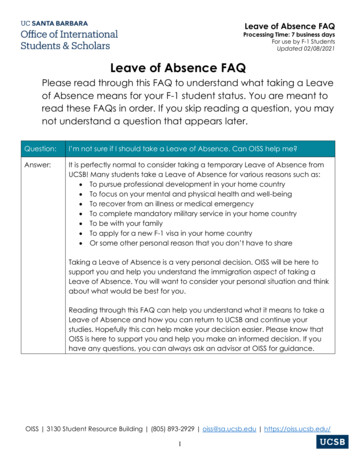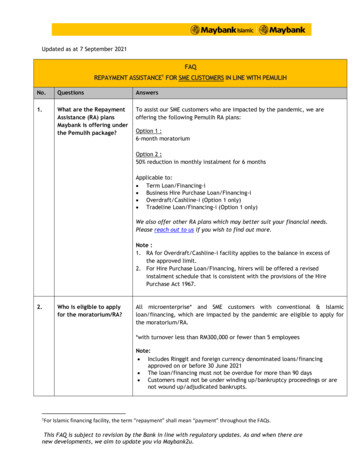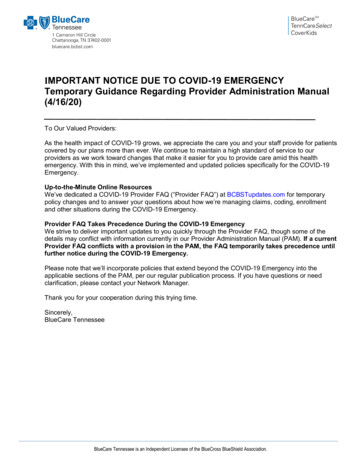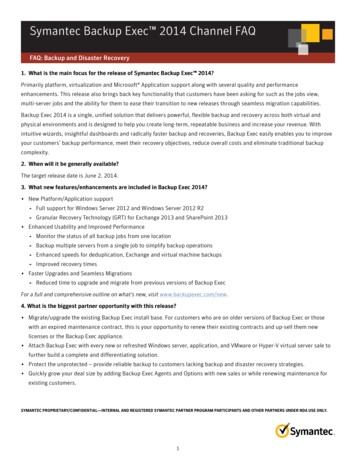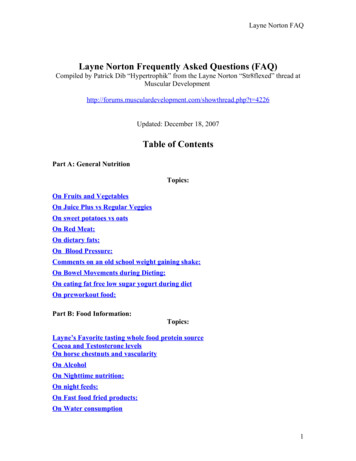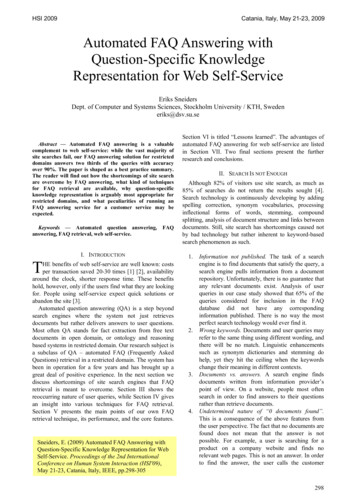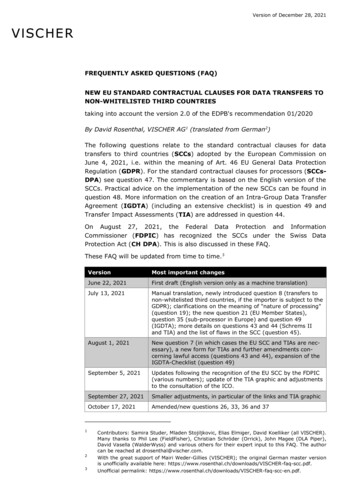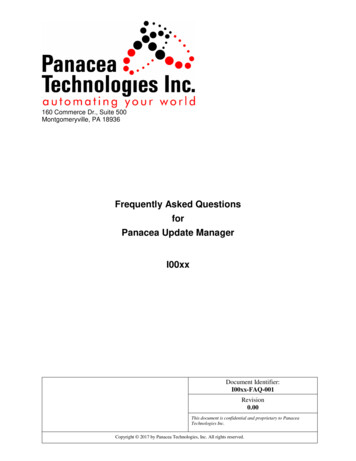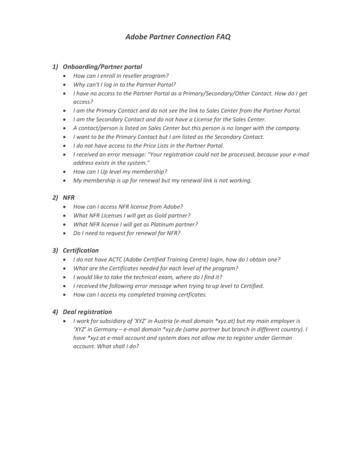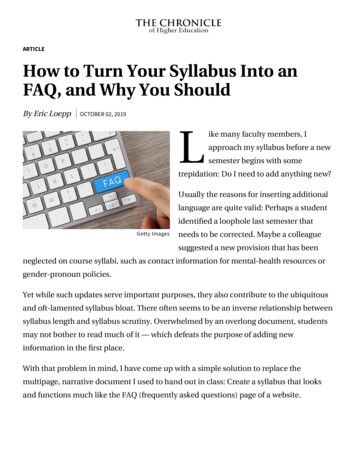
Transcription
ARTICLEHow to Turn Your Syllabus Into anFAQ, and Why You ShouldBy Eric LoeppOCTOBER 02, 2019Like many faculty members, Iapproach my syllabus before a newsemester begins with sometrepidation: Do I need to add anything new?Usually the reasons for inserting additionallanguage are quite valid: Perhaps a studentidentified a loophole last semester thatGetty Imagesneeds to be corrected. Maybe a colleaguesuggested a new provision that has beenneglected on course syllabi, such as contact information for mental-health resources orgender-pronoun policies.Yet while such updates serve important purposes, they also contribute to the ubiquitousand oft-lamented syllabus bloat. There often seems to be an inverse relationship betweensyllabus length and syllabus scrutiny. Overwhelmed by an overlong document, studentsmay not bother to read much of it — which defeats the purpose of adding newinformation in the first place.With that problem in mind, I have come up with a simple solution to replace themultipage, narrative document I used to hand out in class: Create a syllabus that looksand functions much like the FAQ (frequently asked questions) page of a website.
Here’s how it works: I designed my syllabus in a Q&A format on my university’s learningmanagement system, Canvas. My course page on Canvas displays a series of themes,such as "attendance," "grade policies," and "course schedule." When students expandany particular section, a series of questions related to the theme appears. Below is animage from my Canvas home page, with the "attendance" module expanded:Students can click on any question on myFAQ syllabus to get a brief answer. Forexample, if they click on, "What if I am lateto class? Does [my attendance] count?," ashort answer appears: "No. If you are late toclass and miss the attendance sheet, youcannot sign it."The FAQ syllabus offers a number ofadvantages:It allows quick and simple navigation. Rather than flipping or scrolling throughpages of a traditional syllabus, students can easily locate the appropriate section ofan FAQ syllabus and obtain a quick answer. The more accessible the information is,the more likely students will attempt to find it (as opposed to emailing me in a panicat 2 a.m.).Instructors can embed links to web pages or documents in the FAQ answers. Forexample, on my FAQ syllabus, I connect students directly to homework assignments,research sources, contact information for campus services, and more. My goal is forstudents to rarely have to click the "back" button. If the answer page does not haveeverything they need, they should be able to simply click an active link to get to therelevant website or file.An FAQ syllabus allows instructors to prepare answers to follow-up questions aboutthings that aren’t on the syllabus but may pop up as the semester progresses. Forexample, instructors routinely place grading scales on the syllabus, but sometimeswe get specific questions later on — once the grades start rolling in — about issueslike curves, rounding, and extensions. Students may have other questions unique to
the discipline or course. For instance, my field is political science, so I include acommon query on my FAQ syllabus: "Will I be required to share my political viewsout loud?" Many of these types of questions are too cumbersome to attach to analready text-heavy print syllabus. In a digital FAQ form, however, you can offer briefresponses to predictable inquiries that can save you considerable time later in theform of averted emails.Finally, integrating your syllabus with the campus learning-management system(LMS) can help students develop more familiarity and comfort with that systemgenerally. Some students rarely log in to the LMS — perhaps just to locate a due dateor check their grades. An FAQ syllabus encourages them to log into the LMS morefrequently, not just to read the syllabus but to use the rest of the site, too. Forinstance, if students aren’t sure how to submit a homework assignment for my class,they can click on a corresponding question on my FAQ syllabus. The answerexplains how to upload written work to the LMS and includes a direct link to thepage where they can do so. In a world where there is far more information availablethan we can possibly expect students to commit to memory, learning to manage andnavigate an organized set of information within an online system is an important lifeskill.Like any syllabus strategy, the FAQ approach is not without its drawbacks.
The Chronicle ProductivityGuide to Teaching & Presenting 49.00PrintADD TO CARTChief among them is the initial investment of time and effort that goes into converting apaper document to a digital FAQ syllabus. Also, some learning-management systems aremore conducive to this method than others. Finally, some universities, departments, orindividual students may simply prefer — or, in some cases, require — a traditional printsyllabus be made available.I do offer students a downloadable version of the basic syllabus with all universityrequired course information, but I make clear that far more information is available onthe FAQ version. As a result, few students even open the downloadable version.For me and my students, the FAQ syllabus is a net positive. Once digitally constructed, itis no more difficult to update and maintain than any other syllabus, yet is far moreversatile.
Moreover, your own students are a good source of ideas for what needs to be updated onyour FAQ syllabus. For example, create a syllabus quiz that you can also use as anassessment tool: Ask students to identify a question about the course that you haven’tanswered on the syllabus. What piece of information would they like to see added? Whatis unclear? (Students who ask a question that’s already answered on the syllabus earnzero points.)A syllabus quiz not only requires students to read and familiarize themselves with thedocument, but also helps the instructor identify policy voids. If enough students pointout the same problem, that’s probably something you need to fix.Across higher education, we are seeing more and more faculty interest in finding creative— and demonstrably effective — ways to present course information. Professors areexperimenting with all sorts of syllabus strategies, including filming videos, addinginfographics or cartoons, drafting short and simple syllabi that leave most courseinformation to an online repository, mandating graded syllabus quizzes, and burying"Easter eggs" on their syllabi that reward diligent readers.The FAQ syllabus contributes to that worthwhile enterprise: It provides students withaccess to a rich online database that is simple to navigate, but contains more informationthan most paper-based syllabi. The approach has been an asset in my courses; I hope itmay prove equally fruitful for other instructors, too. If anyone is interested in trying it outfor themselves, there are many resources online with tips and best practices for designingFAQ pages.Regardless of what we include on a syllabus, we must be cognizant that how we deliverthat information matters, too — assuming we want students to actually use and benefitfrom it throughout the term.Eric Loepp is an assistant professor of political science at the University of Wisconsin atWhitewater. 2019 The Chronicle of Higher Education
1255 23 rd Street, N.W.Washington, D.C. 20037
an FAQ syllabus and obtain a quick answer. The more accessible the information is, the more likely students will attempt to find it (as opposed to emailing me in a panic at 2 a.m.). Instructors can embed links to web pages or documents in the FAQ answers. For example, on my FAQ syllabus, I connect students directly to homework assignments,
